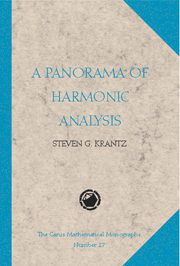Book contents
- Frontmatter
- Dedication
- Contents
- Preface
- 0 Overview of Measure Theory and Functional Analysis
- 1 Fourier Series Basics
- 2 The Fourier Transform
- 3 Multiple Fourier Series
- 4 Spherical Harmonics
- 5 Fractional Integrals, Singular Integrals, and Hardy Spaces
- 6 Modern Theories of Integral Operators
- 7 Wavelets
- 8 A Retrospective
- Appendices and Ancillary Material
- Table of Notation
- Bibliography
- Index
6 - Modern Theories of Integral Operators
- Frontmatter
- Dedication
- Contents
- Preface
- 0 Overview of Measure Theory and Functional Analysis
- 1 Fourier Series Basics
- 2 The Fourier Transform
- 3 Multiple Fourier Series
- 4 Spherical Harmonics
- 5 Fractional Integrals, Singular Integrals, and Hardy Spaces
- 6 Modern Theories of Integral Operators
- 7 Wavelets
- 8 A Retrospective
- Appendices and Ancillary Material
- Table of Notation
- Bibliography
- Index
Summary
Spaces of Homogeneous Type
One of the important developments in harmonic analysis in the 1960s and 1970s was a realization that, in certain important contexts, an axiomatic theory is possible. What does this assertion mean?
The Brelot potential theory gives a version of axiomatic potential theory [CHO]. That is not the focus of the current discussion. In the classical harmonic analysis of Euclidean space, we are interested in maximal operators (of Hardy-Littlewood type), in fractional integrals (of Riesz type), and in singular integral operators. What structure does a space require in order to support analytic objects like these that enjoy at least a modicum of the familiar regularity theory?
If we wanted to do harmonic analysis on the boundary of a domain in ℝN, or on a surface or manifold, or on a Lie group, which of the ideas that we learned in Chapters 1−5 would transfer with ease?
The answer to these questions is obscured by the history of the subject. Classical Fourier analysis is inextricably bound up with the fact that Euclidean space has three natural groups acting on it: translations, dilations, and rotations. The functions x ↦ eix·ξ, for ξ ∈ ℝN, are the characters of the group (ℝN, +) (see Section 2.1). These are the basic units of harmonic analysis on ℝN. They are part and parcel of our study of translation-invariant linear operators (also of the so-called sublinear operators, such as the Hardy-Littlewood maximal operator).
- Type
- Chapter
- Information
- A Panaroma of Harmonic Analysis , pp. 235 - 272Publisher: Mathematical Association of AmericaPrint publication year: 1999



